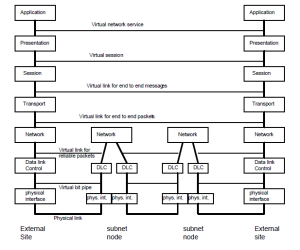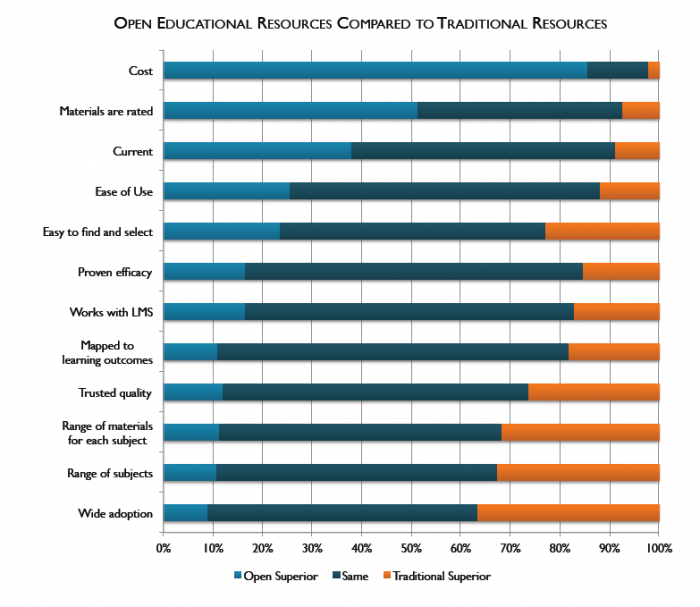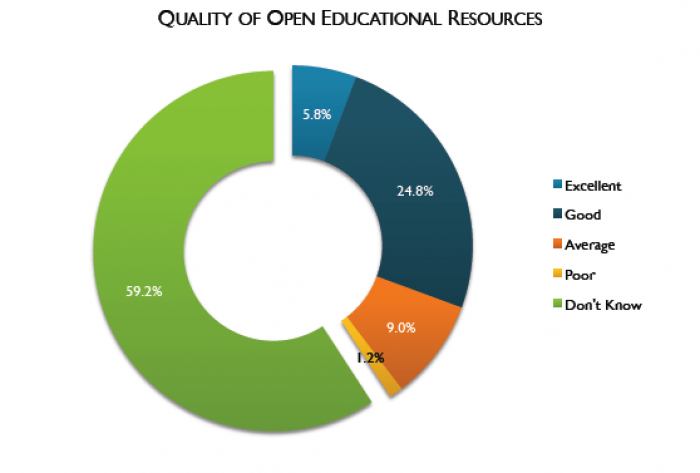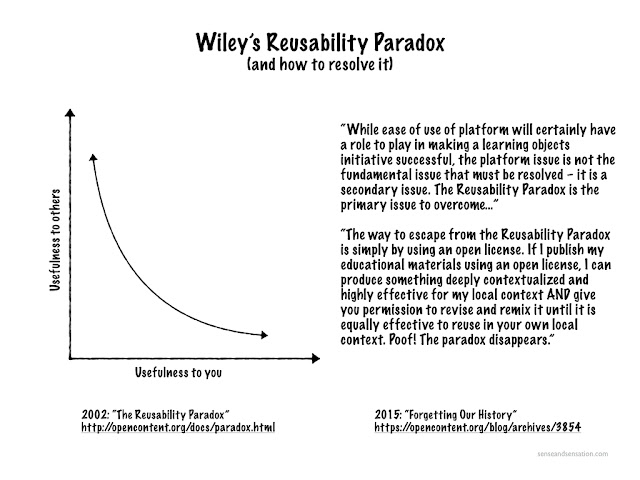- How much of the text will be used, is it under the 10-15% rule?
- If course materials be accessed electronically through our library?
- If we need to request copyright permission to embed the content in our course?
On the OER Hunt!
More Credits – Less Commercial Textbooks
Resolving the Reusability Paradox
Promoting Open Textbooks
- Connect with faculty – survey them and find out who is doing what.
- Go to dept meetings and discuss the issues with faculty.
- Talk to students in student government and the newspaper.
- Find a faculty member in a high stakes, high cost course – such as Biology 100 and pilot.
- Survey those students afterwards and publish the results.
Transparent Educative Experiences (#OpenEdMOOC)
- Evaluate models of content creation and settings in which each is preferable
- Explore the process of finding, assessing, and integrating OERs
Authentic vs. Non-Authentic Materials
The takeaway I get from Downes’s comments for this week is that there is a difference between what I would call authentic vs. non-authentic materials. Downes argues for authentic materials – those created for real-life situations and not necessarily for teaching and learning purposes – to be used in a communicative context where interactions occur for a purpose. He contrasts this with those non-authentic (didactic) materials that presumably are open educational resources (OERs) that are designed for teaching and learning purposes only. Question…Can OERs be authentic?I agree that the educative experience is more important than the course content, teaching materials, or technologies alone, but how much weight do course content or teaching materials, etc. have when compared to the overall educative experience? From a planning standpoint, what comes first, the experience (or performance) itself or the OER? Should I assume that content creation relates to what teachers create for teaching and learning purposes and not what students create as learning outcomes? Or perhaps both? I wish I could substitute this paragraph with answers to these questions, but I can’t at this point. Choosing between authentic and/or non-authentic materials will depend a lot on the educational setting: teacher preferences and past experiences, group and individual profiles, school policy, availability of materials and technology, and overall culture. Thus, the original purpose of the OER or material, object, etc. is of lesser importance than how the OER is ultimately used (modified, mixed, distributed, or retained) given a new context. Perhaps it’s the learning outcome that matters more than whether the material is authentic or non-authentic (or open or not).
Terminology
Wiley came up with the term OER-enabled pedagogy because others could not reach a consensus on the meaning of terms like open pedagogy and open educational practices. But is reaching a consensus on how a community defines a term all that important? I bet many taking this course have different definitions for MOOC, OER, open pedagogy, open educational practices, and even OER-enabled pedagogy. Here are a few questions to illustrate this point:- What is considered massive? Does a course have to be “massive” to be beneficial? (MOOC)
- What aspect(s) of the educative experience remains transparent: curriculum, assessment, instruction, student outcomes, etc.? And transparent for whom: teachers, learners, community, local, global…? And for how long and where? (MOOC)
- Should authentic or non-authentic materials be used (see above)? OERs in the abstract (artifact) or those used in context (artifacts defined within a particular educative experience from both the learner and instructor perspective)? (OER)
- What remains transparent, teaching or learning practices? Didactic materials (both OERs and Non-OERs), course content, learning processes, learner-produced products, or learning environments? (open pedagogy/open educational practices/OER-enabled pedagogy)
Reflection
The first learning objective for week 4 – evaluate models of content creation and settings in which each is preferable – I find much more challenging than the second – explore the process of finding, assessing, and integrating OERs. Any “model” of content creation would depend on school policy and (educator) culture, student body and culture, curriculum, assessment, instruction, and available resources like technology, etc. Before considering any “model”, what’s most important is that educators who are attempting to become more open, have various entry points possible. For instance, perhaps it does not involve any OERs at all, simply sharing a teaching or learning experience that was challenging or successful might be the first step in becoming more open. This might later include adapting or adopting OERs as part of everyday practice… and so on. Given this scenario, it’s hard to look at this process as a particular “model” – but I could be wrong. This is my current mindset as I continue to read and write about this topic this week. Note: Images above show how I decided to gather my thoughts yesterday that led to this post: iPad Pro using Google Keep to take notes while watching YouTube videos in split screen.Finding or creating OERs
Week 4 of OpenEdMOOC is about Creating, Finding, and Using Open Educational Resources. I don’t plan do fulfill the task of delivering a 1 hour lecture using OERs, but I was curious how much I would be able to find and how much I would need to create by myself. I was surprised how easy it was to find things. This is the short message of this post.
If you are interested in a little example from the History of Data Communication, read on.
I have long thought that one day I should create a little graphic, perhaps even an animation, about the OSI 7 layers model, because whenever I saw such a graphic on the web, I was frustrated that it did not emphasize the few aspects that I found fascinating when we built prototype OSI networks.
The basic idea of the services is very simple: Think of two 7-story buildings. In the left-hand one, on the 7th floor, someone wants to send a message to their peer on the 7th floor of the other building. For this purpose, he or she just turns to their aides on the floor below to get this done, without need to think about how all the lower 6 floors of all buildings will collectively delivery that service. The aides on floor 6, in turn, use the services of the all the lower 5 floors in just the same way, and so on.
Now all graphical descriptions that I had seen on the web, enumerated the seven services one after the other, in a loveless way, as if it was a bothersome obligation, such that the listener (if he was not yet asleep) found himself wondering: now what is the difference between transport layer (4) and network layer (3) whose descriptions sounded pretty much the same? (Or likewise, between TCP and IP?) Graphics that left out any 3-floor buildings in between, did not make clear the relaying and routing function of layer 3 and the end-to-end function of layer 4.
Today, the first OER that I found was sufficiently emphasizing both sorts of stacks. I think this is good news.

Source: lecture 1, slide 18, from MIT OCW, CC-BY-NC-SA.
Filed under: OpenEdMOOC
The Troubled Trail from CC-BY to CC-BY-NC #OpenEdMOOC

This week in Introduction to Open Education I was introduced to the course materials on the 5R’s, Creative Commons, and Open Licensing. This is territory that I’m comfortably familiar with, but there’s always something new to learn. One of the ideas that emerged for me, and admittedly it’s been brewing, is the need for a change in how I choose to license and share my work. I have wrestled of late with the ever-growing phenomenon of “open washing” particularly among panicked for-profit publishing companies. I have a less-than-generous view of what publishers are playing at regarding OER.
My example for this post is Cengage’s new OER website (probably an unthinkable concept for them not long ago). I downloaded the Cengage paper called Open Educational Resources (OER) and the Evolving Higher Education Landscape. I had to trade my name, email, and institution for the privilege of downloading it, so already not open.
The following paragraph from the paper is an example of what alarms me about for-profit positions on OER, Cengage states,
In the 2014 Babson survey, participants judged the quality of OER to be roughly equivalent to that of traditional educational resources. OERs were deemed to be more current than traditional publishers’ resources, while traditional resources were deemed superior in the areas of range of subjects, range of materials for each subject, resources mapped to learning outcomes, and trusted quality. Overall, 31% of those who had an opinion on OER rated their quality as excellent or good, versus 56% who rated traditional resources as excellent or good (Cengage, n.d.a.).
Cengage seems to be deliberately misstating what the 2014 Babson survey reported. Either that, or they’re misreading the graphs (neither option instills confidence). What Babson actually reported was that among faculty members that had used OER, – and that’s the only subset that matters for purposes of the comparison of OER to traditional resources – the majority of faculty members found OER either the same or better than traditional resources in every category. See Figure 1 below. And Cengage’s additional statement that “Overall, 31% of those who had an opinion on OER rated their quality as excellent or good,” was actually 76% excellent or good if you remove the 59.2% of faculty members that “did not know,” e.g., did not have an opinion, see Figure 2 below. It’s possible I’m missing something, or that I’m wrong, so I have included the graphs for you to read. Please let me know.
Why would Cengage want to mislead educators about peer perceptions comparing traditional and OER resources? Here’s my hunch. Where Cengage claims to be adding value to OER as part of its sales pitch is in curation (trusted quality), range of materials for each subject, and resources mapped to learning outcomes. Convincing educators that OER somehow fail in these categories makes a business case for Cengage to curate and supplement OER for $25 USD per student, per course (Cengage, n.d.b.).


The kind of OER repackaging that Cengage is engaging in requires the foundational resource to have a CC-BY license. I’m not convinced that CC-BY-SA would pass muster for repackaging, but there’s probably an argument publishers will try to make. If the resource were CC-BY-NC, however, for-profit publishers would not be able to include it in their firmly closed commercial products. While I want to be generous with the work I create, I most certainly do not want it to land in a publisher resell (or a for-profit journal either). Going forward, I’m using CC-BY-NC for my work. Non-commercial is not a complicated license to figure out. Others cannot sell my work, period. Outside of commercial sale, folks can go ahead and use it, if it’s of interest.
This may not seem like a big deal, $25 per student is way better than $115 to $160 (Cengage’s premium Biology textbook pricing), but Cengage’s low-cost solution is only on the table because the highly questionable for-profit publishing practices of the past few decades have contributed to the problem-solving that OER represents. Cengage’s open washing reaction is clear evidence that there is a rising tide of high quality, no-cost, adaptable open resources emerging that learners and educators are ready and willing to use. I want resources to be easy and well-curated as a contribution to educator workload, but it probably doesn’t need to cost $25 USD per learner, per course, probably.
References
Allen, I. E. & Seaman, J. (2014). Opening the curriculum: Open educational resources in U.S. higher education. Retrieved from http://www.onlinelearningsurvey.com/reports/openingthecurriculum2014.pdf
Cengage (n.d.a.) Open for Learning [webpage]. Retrieved from https://www.cengage.com/oer#value
Cengage (n.d.b). Opennow [webpage]. Retrieved from http://www.cengage.com/institutional/opennow
This post is by Jenni Hayman licensed under a CC-BY-NC 4.0 International license.
भक्ति in the Time of MOOC and Yoga in the Open
This past week was the soft start to YogaMOOC. I jumped into the twitter stream, signed up for the edx side, and signed up to be a research subject. I’m also taking #OpenEdMOOC and it was week 3 this past week and I did not do a blog post.
I’m combining some thoughts about both of these into this one post. They are thoughts about behaviour, research, resilience, metaness, and more. I’m hopeful that I can weave them together in a way that makes sense. If not I’m hopeful that you will not judge me too harshly dear reader.
Persistence and resilience: Bhakti in the time of MOOC
As we work through week 0 of YogaMOOC I’ve been dabbling into some of the blog posts (admittedly I have ignored the discussion boards on edX - I feel that this speaks badly of my character somehow but there it is) most are little tester posts just to get something out there; a sentence or two just to say “hey I’m here”. This is valuable as many are starting blogs (or tags or categories) specifically for this mooc. However, others are digging in a little deeper and reflecting on past yoga and meditation experiences. I’d like to do that too but I’ll save that for the next section.
I digress
What really stood out to me as I perused these posts were the occasional ones that reflected on a past yoga or meditation practice that had been abandoned (or diminished) with an interest in rekindling this practice through YogaMOOC. These did not seem to be the majority of the posts but I suppose this featured prominently for me because I know this story well. I have had yoga and meditation practices in the past but they have all fallen off.
This made me think of MOOCs and especially OpenEdMOOC especially considering that I did not post a week 3 blog entry and honestly my week 2 was just a response to someone else not a response to the content or instructors. Persistence in MOOCs was a thing of interest to researchers once - I think it still is. It is one of those that I’ve been flirting with for some time but have yet to really fall into - much like my own yoga and meditation practice.
Okay here I go again with the digressing - forgive me…
I make it no secret that in my youth I was a hippy. Along with certain types of music and dress with such a lifestyle comes certain practices…. Yoga and meditation falls right in. I love yoga and meditation because of the mind/body connection - it is a liminal space.
This in-between of what makes us human. Yoga is often thought of as just physical postures, and while these are beneficial, as we go deeper we are asked to align the mind as we do them.
Meditation is thought of as just sitting and staring at one’s breath but the body ever persists (with aches and pains and cramps) in this state and we are asked to pull the mind back to a fixed point.
It naturally falls into the religious and philosophical with questions such as ‘what are we’ and ‘what happens to the mind after the body is no longer viable’. And with me being all forehead chakra, such questions appeal to me.
I’ve been to India. I’ve done the silent treatment. I’ve followed the master. I’ve climbed the mountain (okay okay … maybe it was just a foothill but that’s what I’ve got). Finally, I’ve just let myself be - and I’ve seen the echo that creates.
What’s next?
Enough digressing…
Persistence
Resilience
Yoga
MOOCs
भक्ति Bhakti is the Sanskrit word for devotion or adoration which makes me think of persistence and resilience. I’ll admit that I could be conflating things here but the path is too enticing for me not to follow it. I can’t put my finger on it quite yet but it is right there…
is it persistance out of blind practice
or out of …
(fine I’ll say it)… love?
Does it matter?
Perhaps these are two paths to the same end?
Which is easier to measure?
Researching the Intimate: Yoga in the Open
I decided to also be a research subject for YogaMOOC but I have to admit it was difficult for me. I love LINKLab MOOCs and I’ve been a research subject for them before. I’m not sure what was different this time. I filled the stuff out but it just felt more … idk… closer to home this time.
The questions were increasingly intimate. I should have paid better attention but as often happens with me (and I suspect many of us) I just kept filling in answers. As I remember it and have gone back to pick a bit…
The regular demographic stuff and with a particular nod to yoga:
How much do you make a year. How much experience with yoga do you have.
But it was the stuff after that …
The stuff about deliberately noticing sensations on the body when doing mundane tasks. The stuff about being self critical. The part about watching my feelings. The parts about meta… cognition, experience, emotion, … idk… life… that was hard for me - in that it felt really close to home.
I come from a tradition (that admittedly in which my bhakti is low) where we live in silence for ten days or so at a time in quiet reflection. We think about these things but we don’t discuss them in the open. In fact, the only dialog is in private consultation with a teacher.
Of course this research is not sharing the results with everyone but I’m not even sure myself what the research questions are? Did I miss that part? Will I get to reflect on how my data fit into the larger project?
I don’t know - I suppose it is a small thing but I can’t help wonder. I don’t mind sharing but I feel like I’m missing some kind of reciprocation… I still filled the stuff out… but it just feels strange to me…
I’m looking forward to YogaMOOC and OpenEdMOOC and few other MOOCs that I’m playing with at this time.
These are just some thoughts - let’s see what comes next.
Till next time,
शरद (aka Monsoon)
Image Credit: Yoga Baby - photographer: me
Check it here
Stuck in the Middle
I will give you a few moments to tap into your memories from the title. Depending on your age and disposition, it might be the Stealers Wheels, one of the many nasty scenes from Reservoir Dogs, or perhaps even a hokey show from Disney. It is also where I find myself. Stuck in the middle and on the ground.
Pancake Bay, Lake Superior
Deep appreciation to David Wiley for underscoring misaligned incentives for OER adoption at the post secondary level. Having worked in K-12, I understand how powerful the direct link between savings and adoption. The link is removed when we move to post-secondary; educators expend effort to adopt | adapt an open resource and the learners are rewarded. Although ultimately well worth the effort, it is problematic.
At certain times, the rhetoric of open with its altruistic goals seems quite lofty ~ speaking from high up in the clouds. There must be an explanation for why the frankly no-brainer adoption of OER hasn’t swept through education. With their cost savings, collaborative nature, agency building, and embodiment of sunshine rules e.g., share, there must be many on the ground hurdles and hiccups why OER aren’t yet ingrained.
Pancake Bay, Lake Superior
Hurdle 1
I write this week one into a strike (all faculty at the Ontario’s 24 community colleges are involved). Although the Union may have muddied the waters with multiple points of contention, my focus in the number of part time faculty ~ estimates vary but hover around 75%. The 75% of faculty are not compensated for: course development, assessment and evaluation, or learners’ issues outside of class e.g., answering emails, satisfying CAAPs, intra-group dispute resolution. Compounding these issues ~ they can be hired on Friday to teach on Monday. Here, the publisher is more saviour than pusher or villain, providing a life line and something around which to structure the next 14 weeks. If the educator is lucky enough to come up for air over the semester, it will be to attend a workshop on X to make Y easier, but not to explore an open alternative to the costly publisher’s text ~ especially since the educator may never touch or teach that course again.
If we continue to have educators parachuting in to deliver course content, the curation or creation of OER to build meaningful educational environments and experiences for both learners and educators will remain out of reach.
Hiccup 1
I am bracing for the backlash… from my perspective, over a decade of assisting faculty colleagues across all 125 programs at the college in my position first as a Librarian and more recently as an Educational Designer (part ID, part curriculum designer) OER are more mature and accessible in some disciplines over others. I am not entering the quality debate, but not all programs have usable OER; they haven’t been developed. Reasons vary from Canadian perspective, more vocational focus of community college content, AODA compliance, etc. We haven’t yet reached the tipping point and may still need a bridge for some disciplines. This bridge would not only be for the resources themselves, but also for educators to more easily cross over ‘from the dark side into the light’. Affordable Course Content (ACC) through existing library resources could serve as the bridge.
As strange as it seems to be writing this on the eve of Open Access Week, current library databases already paid for through learners’ ancillary fees should be used as course resources. The learners incur no additional fees for textbooks | course material and educators begin to learn the benefits of curation. Database discovery layers may not be perfect, but one place to perform a federated search for current and relevant content provides comfort to educators treading water in the sea of information. If it also boosts collaboration with the Library and respect for the skill set of Librarians, so be it!
It took me a few years working in education to realize that people don’t always embrace change. It may seem obvious to many, but for me it was truly difficult to sympathize as I tended to basically crave change. The current climate and conversation tends to pit pricey publishers against the omnipotent OER movement. This may be too shocking for many educators who need to wade in or scaffold up. ACC through existing, fee-based resources provide this gentle push away from publishers and toward OER. Ideally, this is temporary ground. When OER mature across all disciplines and awareness grows beyond the grassroots, ACC secedes to OER.
Clearing Hurdles and the Hiccups
With gratitude to individuals working hard to grow awareness and inform on the benefits of OER, it may be time in the life of OER for a more authority innovation decision ~ a move away from the grassroots to an organizational commitment. This is where all the elements of a social system, with its external influences e.g., government and internal influences e.g, students | student associations combine to normalize OER.
Unfortunately, from my perch within the community college system, there is still the highest of hurdles or most persistent of hiccups. The majority of administration in community colleges do not have qualifications in the field of education. Their primarily business backgrounds make the ethics and ethos surrounding OER a ‘tougher sell’.

